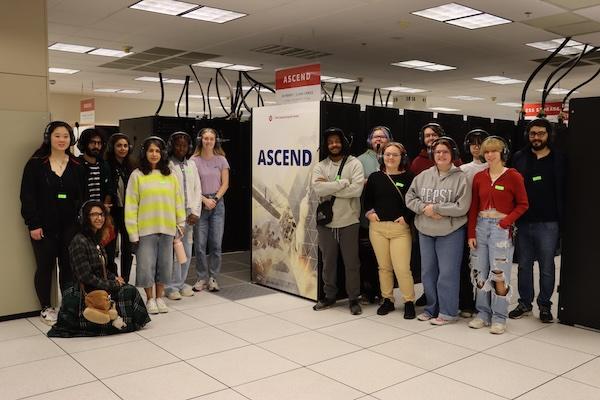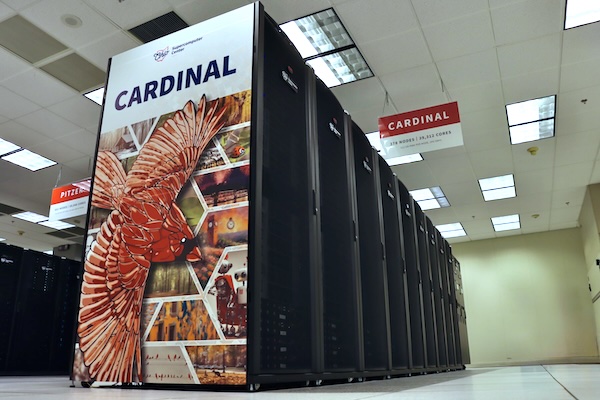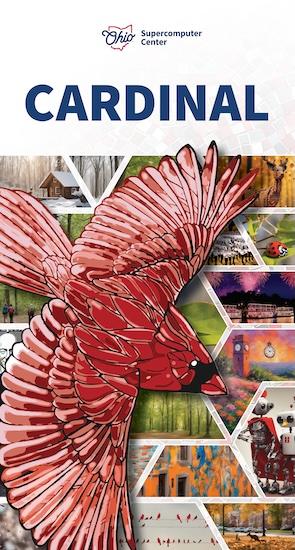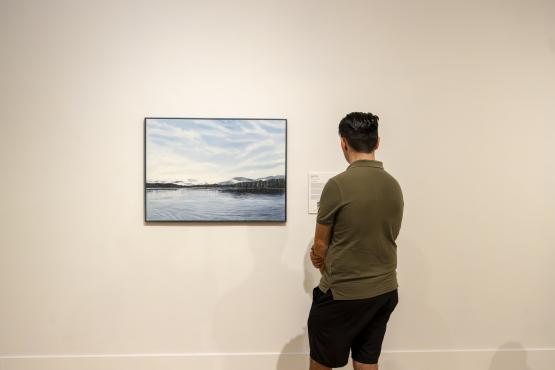

Blending art and AI: Students harness supercomputing power for a unique design challenge
Ohio University students collaborated with the Ohio Supercomputer Center (OSC) to create a decorative endcap for Cardinal, a powerful new supercomputer housed at the OSC. Cardinal supports advanced research in fields like artificial intelligence, data science, and engineering. The endcap is a large visual panel mounted at the end of the system, blending art and technology.
By Lexi Biasi | April 2, 2025
Share:
On a rainy Friday last October, 14 Ohio University Digital Art and Technology students arrived at the Ohio Supercomputer Center (OSC) in Columbus, eager to take on a one-of-a-kind challenge. Their task: design the endcap for OSC’s newest high performance computing (HPC) cluster, Cardinal, using the cluster’s own advanced artificial intelligence (AI) capabilities.
Basil Masri Zada, a faculty member in Ohio University’s Digital Art program, emphasized how the endcap project aligned with the students’ coursework.
“It’s important for students to understand how technology can enhance their artistic practice,” he said. “This project is giving them a real-world application of how art and technology can intersect in a professional setting.”
The endcap design project is part of a broader partnership between OSC and Ohio University, rooted in their shared mission to advance technology’s role in creative disciplines. This collaboration began in 2023 when Masri Zada worked with OSC to integrate the AI tool Stable Diffusion Automatic 1111 into the curriculum for the university’s new Digital Arts and Technology concentration.
By hosting the tool on OSC’s HPC systems and providing access through its remote platform Open OnDemand, OSC made the technology available to students on any device, allowing access to those without high-powered equipment. Originally launched to support coursework, the partnership soon expanded into real-world applications—now allowing students to leave a lasting, visual mark on OSC’s supercomputing resources.
A blend of creativity and technology
For the design, students were tasked with creating a visual narrative that incorporated imagery symbolic of Ohio. They brainstormed and developed AI-generated images that reflected their personal connections to the state. Scenes of Ohio’s nature, innovation and even the campus squirrels—familiar to every Ohio University student—were layered behind the state bird and supercomputer namesake: the cardinal. The composition was designed and composed by Masri Zada, who also illustrated the bird influenced by a referenced AI generation, as a collage to include all the students' works equally.

Using Cardinal’s computing power enabled faster and more complex experimentation than they’d experienced before.
“Before, we would have had to wait overnight for a few images and now we can create dozens in under an hour,” said Faun Winthrop, a senior studio art, digital art and technology major. “The speed and efficiency are amazing. This kind of technology is helping us push our creativity faster than before.”
The experience highlighted more than speed—it demonstrated AI’s ability to elevate creativity. “It’s not just about creating art faster; it’s about seeing how AI can augment what we do,” Winthrop said.
For Moss Conner, a junior digital art and technology major, the project revealed exciting new possibilities. “We’ve just been creating assets using AI and it’s been so interesting to see our AI-driven work next to some of the non-AI projects that have been done in the past,” Conner said. “The resolution and capabilities of the system are allowing us to do things we weren’t capable of before.”
Bringing Cardinal to life
Ethics in AI art
While students embraced the technological benefits of using AI, curriculum and University policy also forced them to consider the ethical implications of their work.
“It’s cool to see how far we’ve come; now we’re using it to design something that will be part of OSC’s history,” said Addie Smith, a senior studio art, digital art and technology major. “But it’s also important that we’re doing it ethically. We’re creating a database that’s safe to use, where our work isn’t taking from other artists. That feels important.”
This emphasis on ethics aligns with Ohio University’s stance on the responsible use of AI. The University’s position on generative AI stresses its role in fostering ethical practices while enhancing learning.
“Empowering AI literacy requires at least two components: effective practices and ethical considerations and contexts for critical use,” the statement partially reads—a philosophy Masri Zada echoes in the Digital Art program.
“It’s crucial that we approach this technology with a sense of ethics and awareness,” he said. “That’s why this project has been such a great learning experience for them—they’re learning to be part of a larger conversation about the ethical use of AI in the arts.”
A lasting impact

“OSC is incredibly excited about this collaboration, as it demonstrates how college students in Ohio are using and benefiting from our HPC resources,” said Alan Chalker, OSC director of strategic programs. “We’re seeing demand from a wide range of new disciplines—from the arts to the social sciences—that may not have traditionally used our resources in the past but are interested in harnessing the power of HPC for research and creative work.”
The project also ties into OSC’s deep-rooted history in digital art. While touring the OSC facility, the students viewed artwork by Charles “Chuck” Csuri, a pioneering computer artist and one of OSC’s founders. Csuri’s groundbreaking work in digital art and computer graphics helped lay the foundation for today’s AI-driven creative tools.
As they move forward in their own careers, the experience of blending AI with art—and witnessing its history firsthand—will stay with them.
“It’s exciting to be part of something that will be used for years to come,” Winthrop said. “Knowing that our work is part of the new Cardinal system makes this even more special.”
“I’m really proud of my students for embracing this technology and for the thoughtful approach they’ve taken with it,” Masri Zada said. “This is just the beginning, and I’m excited to see how they continue to develop their work with AI in the future.”
Contributing artists include:
- Basil Masri Zada, Ph.D.
- Hannah Dickerson
- Mason Mauzy
- Peridot Smith
- Addie Smith
- Wren Denny
- Shima Mousavizadeh Markieh
- Sara Pirahmadian
- Esther Yali-Williams
- Faun Winthrop
- Moss Conner
- Sarah Shockey
- Fynn Wiseman
- Minjoon Lee
Visit the OSC’s web site to see the individual artwork created by each participant.
The Ohio Supercomputer Center (OSC) addresses the rising computational demands of academic and industrial research communities by providing a robust shared infrastructure and proven expertise in advanced modeling, simulation and analysis.
This article originally appeared on the Ohio Supercomputer Center web site.



